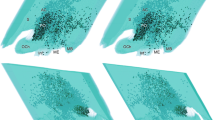Summary
The monoamine containing structures of the human fetal hypothalamohypophyseal tract were studied histochemically by demonstrating the formaldehyde induced fluorescence. First specific fluorescence in the hypothalamus and median eminence was observed at the age of 15 weeks. A sparce network of fluorescent nerve fibres was found to line the walls of the ventricle. Weakly fluorescent cells were found within the stromal cell cords of the adenohypophysis at the age of 11 weeks. Both the number and the fluorescence intensity of these cells increased up to the age of 15 weeks. The apperance of the monoamines in the cytoplasm of the adenohypophyseal cells correlates well with the previous observations on the onset of the function of the fetal adenohypophysis. The lack of monoaminergic innervation of the hypothalamus and median eminence suggests that the hypothalamoadeno-hypophyseal neurohumoral regulation might not be functional during the first trimester of pregnancy.
Similar content being viewed by others
References
Andersen, H., Bulow, F. A., Mollgård, K. von: The histochemical and ultrastructural basis of the cellular function of the human foetal adenohypophysis. Progr. Histochem. Cytochem. 1, 153–184 (1970).
Baillie, A. H., Ferguson, M. M., Hart, D. M. K.: Histochemical evidence of steroid metabolism in human genital ridge. J. clin. Endocr. 26, 738–741 (1966).
Bearn, J. G.: The role of the hypothalamus of the rabbit foetus in the functional development of the foetal pituitary. Abstract. 81 st meeting of American Association of Anatomists. April, 1968. Anat. Rec. 160, 311 (1968).
Björklund, A., Falck B.: Pituitary monoamines of the cat with special reference to the presence of an unidentified monoamine-like substance in the adenohypophysis. Z. Zellforsch. 99, 254–264 (1969).
Bloch, E.: Metabolism of 4-14C-progesterone by human fetal testis and ovaries. Endocrinology 74, 833–845 (1964).
Corrodi, H., Hillarp, N.-A., Jonsson, G.: Fluorescence methods for the histochemical demonstration of monoamines. 3. Sodium borohydride reduction of the fluorescent compounds as a specificity test. J. Histochem. Cytochem. 12, 582–586 (1964).
Dahlström, A., Fuxe, K.: Monoamines and the pituitary gland. Acta endocr. (Kbh.) 51, 301–314 (1966).
Eränkö, O.: The practical histochemical demonstration of catecholamines by formaldehyde-induced fluorescence. J. roy. micr. Soc. 87, 259 (1967).
Fink, G., Smith, G. C.: Ultrastructural features of the developing hypothalamo-hypophysial axis in the rat. A correlative study. Z. Zellforsch. 119, 208–226 (1971).
Fukuchi, M., Inoue, T., Abe, H., Kumahara, Y.: Thyrotropin in human fetal pituitaries. J. clin. Endocr. 31, 565–569 (1970).
Fuxe, K.: Cellular localization of monoamines in the median eminence and the infundibular stem of some mammals. Z. Zellforsch. 61, 710–724 (1964).
Fuxe, K., Hökfelt, T.: Monoamine afferent input to the hypothalamus and the dopamine afferent input to the median eminence. In book Progress in Endocrinology (Proceedings of the 3rd Internat. Congr. of Endocrinology, Mexico 1968), p. 495–502. Amsterdam: Ed. Carlos, Gual 1969.
Gillman, J.: The development of the gonads in man with consideration of the role of fetal endocrines and histogenesis of avarian tumors. Contr. Embryol. Carneg. Instn 32, 81–132 (1948).
Huhtaniemi, I., Ikonen, M., Vihko, R.: Presence of testosterone and other neutral steroids in human fetal testes. Biochem. biophys. Res. Commun. 38, 715–720 (1970).
Hyyppä, M.: Brain monoamines in relation to assumed sexual differentiation of the human fetal brain. Scand. J. clin. Lab. Invest. 27, 64 (1971), suppl. 116.
Keller, P. J., Lichtensteiger, W.: Stimulation of tubero-infundibular dopamine neurones and gonadotrophin secretion. J. Physiol. (Lond.) 219, 385–401 (1971).
Lichtensteiger, W.: Katecholaminhaltige Neurone in der neuroendokrinen Steuerung. Prinzip und Anwendung der Mikrofluorometrie. Progr. Histochem. Cytochem. 1, 185–276 (1970).
Niemi, M., Ikonen, M., Hervonen, A.: Histochemistry and fine structure of interstitial tissue in human foetal testis. In: Endocrinology of the testis (ed.) G. E. W. Wolstenholme and M. O'Connor) (Ciba Foundation Colloquia on Endocrinology), p. 31–52. London: J. & A. Churchill Ltd. 1967.
Niemineva, K.: Observations on the development of the hypophysial portal system. Acta pediat. 39, 366–377 (1950).
Olson, L., Ungerstedt, U.: A simple high capacity freeze-drier for histochemical use. Histochemie 22, 8–19 (1970).
Pearse, A. G. E., McGregor, M. M.: Functional cytology of the pituitary gland. Ann. Rep. Brit. Emp. Cancer Camp. 2, 665–666 (1964).
Ploem, J. S.: The microscopic differentiation of the colour of formaldehyde induced fluorescence. Progr. Brain Res. 34, 27–38 (1971).
Author information
Authors and Affiliations
Rights and permissions
About this article
Cite this article
Partanen, S., Hervonen, A. Monoamine—Containing structures in the hypothalamo-hypophyseal system in the human fetus. Z. Anat. Entwickl. Gesch. 140, 53–60 (1973). https://doi.org/10.1007/BF00520717
Received:
Issue Date:
DOI: https://doi.org/10.1007/BF00520717




